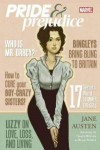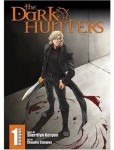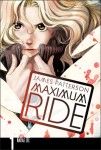Prose Adaptations. Yay? or Nay?
 How interested are readers in graphic novel adaptations of prose titles?
How interested are readers in graphic novel adaptations of prose titles?
To consider this question, I looked at recent adaptations to see how well they circulate against my general graphic novel collections.
In my library’s adult collection of over 1,600 titles, none of the top 100 in terms of circulations are adaptations. At number 101, is Nancy Butler’s adaptation of Jane Austen’s Pride & Prejudice. Equally popular is The Dark Tower: The Gunslinger Born, a series related to but not directly adapted from Stephen King’s popular prose series. Next up is Darwyn Cooke’s adaptation of Richard Parker’s Hunter. The Exile, Diana Gabaldon’s Outlander spin-off graphic novel, R. Crumb’s Book of Genesis and Laurell K. Hamilton’s Anita Blake series rank in the middle range of popularity.
Adaptations of classics, including JinSeok Jeon’s One Thousand and One Nights and Gareth Hind’s The Odyssey stand on the list just after the far better known Anita Blake, showing that quality and appeal can compete admirably with name recognition.
 The losers among adaptations? NBM’s Treasury of Murder series, which is a shame considering the high quality of their adaptations. Sherrilyn Kenyon’s Dark Hunters series is also a low performer. Interestingly, this is a series I continued to purchase because a reader specifically requested them. In my library, it has a small, but dedicated audience. The Dresden Files adaptations have also sat on the shelf, which is surprising considering how popular the novels are and how open many speculative readers are to trying out the graphic novel format.
The losers among adaptations? NBM’s Treasury of Murder series, which is a shame considering the high quality of their adaptations. Sherrilyn Kenyon’s Dark Hunters series is also a low performer. Interestingly, this is a series I continued to purchase because a reader specifically requested them. In my library, it has a small, but dedicated audience. The Dresden Files adaptations have also sat on the shelf, which is surprising considering how popular the novels are and how open many speculative readers are to trying out the graphic novel format.
 On the teen side, there are a few that stand out. Anthony Horowitz’s Alex Rider, James Patterson’s Maximum Ride, Orson Scott Card’s Ender, and Ian Colfer’s Artemis Fowl adaptations all do tremendously well for the genre. Point Blank, from the Alex Rider series, is right near the top with original works Akira Toriyama’s Dragon Ball and Raina Telgemeier’s Smile.
On the teen side, there are a few that stand out. Anthony Horowitz’s Alex Rider, James Patterson’s Maximum Ride, Orson Scott Card’s Ender, and Ian Colfer’s Artemis Fowl adaptations all do tremendously well for the genre. Point Blank, from the Alex Rider series, is right near the top with original works Akira Toriyama’s Dragon Ball and Raina Telgemeier’s Smile.
The losers for younger readers include NBM’s often lovely adaptations of classic fairy tales including P. Craig Russell’s Fairy Tales of Oscar Wilde, the Anne Frank House authorized biography of Anne Frank, Ellen Schreiber’s Vampire Kisses, D. J. MacHale’s Merchant of Death, and Dean Koontz’s Odd Thomas adaptations. That New York Times multi-week best-selling adaptation of Stephenie Meyer’s Twilight? The first volume ranks at #300 while the second volume has yet to be checked out.
What conclusions should we draw from all of this number crunching?
My thoughts:
- Just because a series is popular in prose does not mean you can slap together an adaptation into the graphic novel format with rushed art and lackluster attention to adapting dialog and have it succeed. I think many of those adaptations of popular series that have failed are simply poorly made graphic novels. Sometimes it’s the fault of a publisher pushing an adaptation too fast into production, and sometimes it just doesn’t gell in the graphic format.
- Readers do not easily jump from one format to another. Some titles will be popular by sheer name recognition, and some will be as an engaging way to comprehend a difficult text (i.e. The Odyssey), but many popular prose titles aren’t going to attract graphic novel readers nor are they going to bring that title’s readers to the format. Unless both writing and art are really solid, any adaptation will never be as popular as original material in the medium.
- Original material always circulates better, so I only collect adaptations if they are requested specifically by readers or if they are lauded in many a review from multiple sources. Adaptations make up around 3% of my adult collection, and thus far I see no great reason to change that percentage.
What have your experiences been? How much of your budget do you devote to collecting adaptations of prose in the graphic format?


January 3rd, 2012 at 12:16 pm
[…] librarian’s look at what makes graphic novel adaptations popular « Previous post […]
January 6th, 2012 at 11:58 am
Ms. Telgemeier’s “Smile” is not, as far as I’m aware, an adaptation of a prose work. She is the artist behind several Baby Sitter’s Club adaptations though.
January 6th, 2012 at 1:07 pm
Sarah and everyone, just to clarify, I did not intend to imply that Smile is an adaptation. It’s not, nor is Dragon Ball. I included those titles to show that the mentioned adaptation, Point Blank, is as popular as those two VERY popular graphic novels. I’m sorry if that wasn’t clear. I’ve edited the sentence to make it more clear. Thanks for the catch!